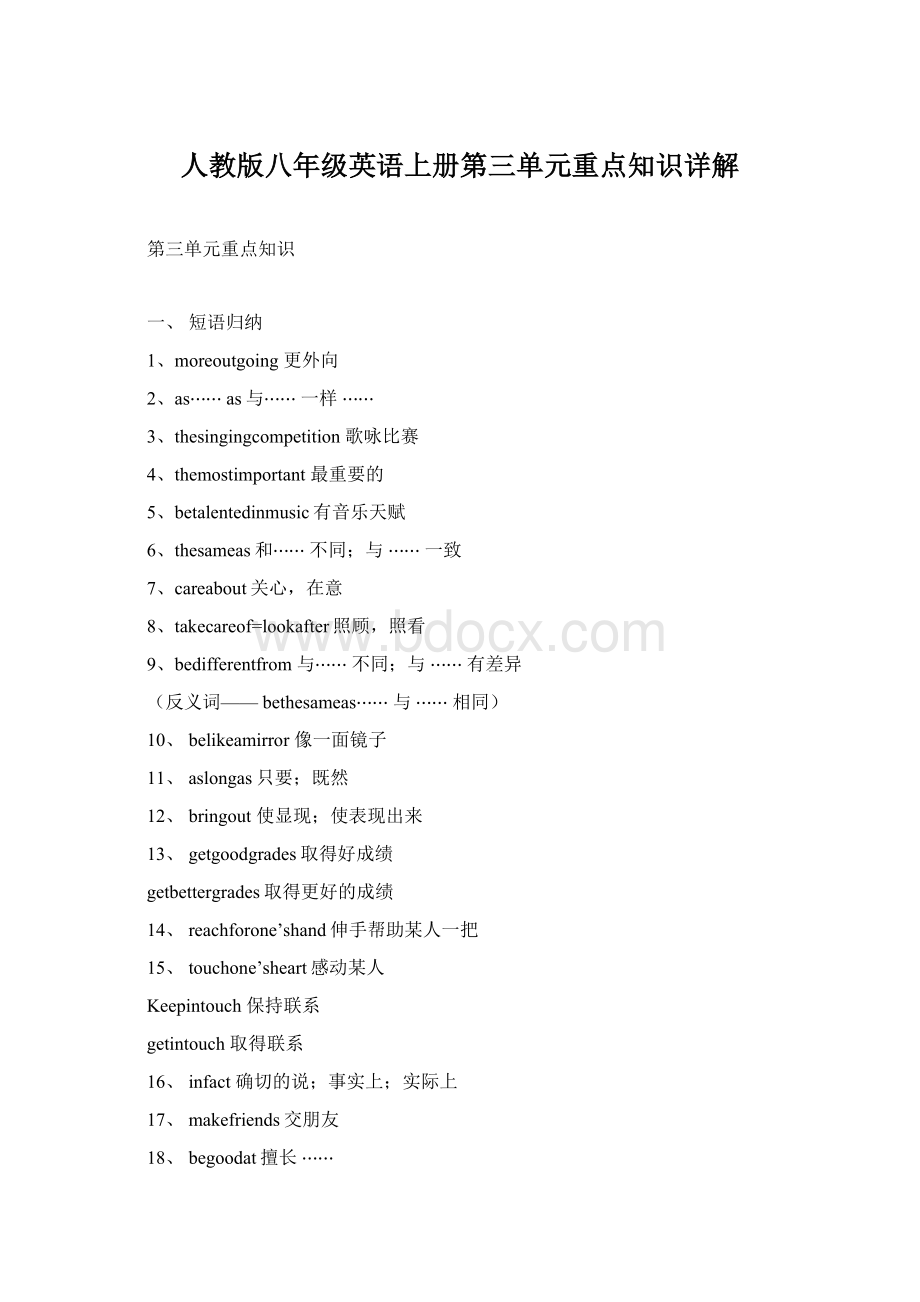人教版八年级英语上册第三单元重点知识详解Word下载.docx
《人教版八年级英语上册第三单元重点知识详解Word下载.docx》由会员分享,可在线阅读,更多相关《人教版八年级英语上册第三单元重点知识详解Word下载.docx(19页珍藏版)》请在冰豆网上搜索。

27、arminarm臂挽臂
withopenarms张开双臂
二、用法集萃
1、havefundoingsth
2、both⋯⋯and⋯⋯⋯⋯和⋯⋯⋯都;
既⋯⋯又⋯⋯
3、loud(形容词,喧闹的,大声的,响亮的)+ly——loudly(副词,喧闹地,大声地,响亮地)
4、quiet(形容词,安静的)——+lyquietly(副词,安静地)
5、talent(名词,天资,天赋,天才)+ed——talented(形容词,有才能的;
有才干的)
6、beseriousabout对⋯⋯认真
2019-8-5
Serious(形容词,认真的;
当真的;
严重的;
危急的)+ly——seriously(副词,严肃地;
严重地;
认真地)
7、makesbdosth让某人做某事
Makesb/sth+形容词让某人/某物⋯⋯
Makesb+名词让某人成为⋯⋯
8、That’swhy⋯⋯这便是为什么⋯⋯,这就是⋯⋯
That’sbecause⋯⋯这是因为⋯⋯
9、It’s+形容词+for/ofsb+todosth对某人来说,做某事是⋯⋯
(此处It是形式主语,真正的主语是后面的不定式短语(todo)
Itisnecessaryforpeopletohavefoodandwatereveryday.
It’sveryniceofyoutolendanumbrellatome.
10、It’snecessary(forsb)todosth对某人来说做某事很必要
11、bringout使显现、使表现出
bringoutthebest/worstinsb把某人最好/最坏的一面表现或显露出来
Pleasetellmehowtobringoutthebestinme.
12、sharesthwithsb和某人分享某物
It’snecessaryforkidstolearntosharetheirideaswithfriends.
13、bethere——随时提供帮助,时刻准备伸手相助,随叫随到,不离⋯左右
Heisalwaysthereforme.
14、information——不可数名词,意为:
“信息,消息”。
apieceofinformation——一条信息twopiecesofinformation——两条信息
三、词类辨析
1、both⋯⋯and/bothof/all/allof/either⋯⋯or⋯⋯/neither⋯...nor⋯⋯/notonly⋯⋯butalso⋯⋯/anyother
“两者
都⋯”,
连接两
both⋯⋯and
个并列
BothmyfatherandmymotherhavebeentoShanghai.
主语
时,谓
语动词
用复数
意为:
都”,作
bothof+复数人称代词
Maybebothofthemarebusy.
或复数名词
形式
用于三
者或三
Allarehere.
all
者以
Allissilent.(万籁俱寂)
上,表
示
allof
either⋯⋯or⋯⋯
neither⋯...nor⋯⋯
notonly⋯⋯butalso⋯⋯
“都”。
注:
1、
作主语
时,笼
统的表
示所有
人时,
谓语动
词用复
数形式
2、笼统
的表示
所有事
物或现
象时,
词通常
用单数
(三者
以上)
都
“或
者⋯或
者⋯”
在连接
根据靠
近的主
语名词
确定单
复数
(就近
原则)
“既
不⋯也
不⋯”
就近原
则
“不
但⋯而
且⋯”
EitheryouorIamwrong.
NeitherMarynorTomworksinthisschool.
NotonlyallthestudentsbutalsotheirEnglishteacherhasreadthestorybook.
其他任
何一个
anyother+名词单数
以上任
何一
个)
Shanghaiislargerthanany
othercityinChina.
A——bothof⋯⋯,allof⋯⋯作主语时,谓语动词用复数形式;
noneof⋯⋯作主语时,谓语动词可以用单数也可以用复数;
eitherof⋯⋯,neitherof⋯⋯作主语时,谓语动词要用单数。
B——both,neither,either,all,none,any都可以与of连用,后面的人称代词要用宾格2、hard-working/hardwork/workhard
hard-working
形容词,“工作努力的,
Heisahard-workingboy.
辛勤的”
名词短语,“辛苦的工
hardwork
作”,hard是形容词,修
Whathardworkitis!
饰不可数名词work
短语动词,“努力工作”,
workhard
hard是副词,修饰动词
Healwaysworkshard.
work
3、laugh/smilelaugh
smile
4、belike/looklike
“出声地大笑”,不但有laughat——“嘲笑,因⋯
面部表情,而且还有声音而发笑”“无声地微笑”,指的是
smileat——向⋯微笑
面部表情
belike
looklike
像⋯一样
看起来像
侧重人的“内在气质,如:
品质、性格、品行等”侧重人的“外貌,如:
高、矮、
胖、瘦”
Kateislikehermother.Theyarebothquiet.
Katelookslikehermother.Theyarebothtallandthin.
5、theother/theothers/other/others/another
特指“两者中的另一个”,
theother
one⋯⋯theother⋯⋯——“一个⋯另一
个⋯”,后可接数词或复数名词,特指
“其他的”
特指某一范围内的“其他的人或物”,
theothers
是theother的复数形式,相当于
“theother+复数名词”
other
作形容词或代词,泛指“别的,其他的”,
只修饰复数
作代词,泛指“其他的人或物”,不能
others
修饰名词,可与of连用,后跟
them/us/you或特指的复数
another
泛指三个或三个以上同类事物中的“另
一个”,代替或修饰单数可数名词
Hehastwobrothers.Oneisateacher,andtheotherisadoctor.
Youtwostayhere,andtheothersgowithme.
WelearnChinese,math,English,andothersubjects.
Somestudentsaredoinghomework,othersaretalkingloudly.Idon’tlikethisone.Pleaseshowmeanother.Other,theother,another,others
同步练习
1.There’sno_____waytodoit.
A.other
B.theother
C.another
Dothers
2.
Somepeopleliketorestintheirfreetime.
______liketotravel.
A.Other
B.Theothers
C.Others
D.Another
3.
Thiscakeisdelicious!
CanIhave_______piece,please?
B.another
C.others
D.theother
4.
Whereare______boys?
A.theotherB.theothers
C.othersD.another
5.
Thesupermarketison_____sideofthestreet.
C.theother
D.others
6.Therewerethreebooksonmytable.Oneishere.Whereare___?
A.othersB.theothersC.theotherD.another
7.Someofthespeakerswentstraighttotheconferenceroom.____speakersarestillhangingaround.
A.Theother
B.Theothers
C.Another
D.Others
8.Thisisnottheonlyanswertothequestion.Thereare_____.
A.theothersB.others
9.Pleasegiveme____chance.
B.theother
D.theothers
11.
Idon’tlikethoseshoes.Pleaseshowme______.
A.another
B.other
D.someothers
12.
Marydidn’twant____ofthetwokindsandaskedtheshopassistanttoshowher______.
A.both;
theotherB.all;
theothers
C.either;
another
D.other;
13.
Mr.Turnerboughttwobikes.Onewasforhiswife,and____wasforhisson.
B.otherC.theother
D.one
14.hehastwosons.Oneisadoctor,____isastudent.Heisnowstudyingat_____university.
A.another;
a
B.theother;
anC.theother;
D.another;
an
15.
---Wouldyoulike_____apples?
----______,please.
A.somemore;
anothertwo
B.anymore;
TwomoreC.another;
twomore
D.somemore;
Othe
r
16.
Therearetwenty-eightstudentsintheclass.Tenofthemaregirlsand_____areboys.
A.theother
B.theothers
D.other
17.
Idon’tlikethispen.Wouldyoupleaseshowme___one?
B.theother
C.other
18.
Ihavesixcoloredpencils;
oneisblue,anotherisred,and_____aregreen
A.others
19.----Haveyoufinishedyourreportyet?
----No.I’finishllitin______tenminutes.
A.anotherB.otherC.moreD.less
四、重点语法
㈠、形容词、副词的比较级和最高级⑴大多数形容词和副词有三个等级:
原级、比较级、最高级;
⑵比较级表示——“更⋯”,用于两者(人或事物)之间的比较;
最高级表示——“最⋯”,用于三者或三者以上的(人或事物)之间的比较;
⑶比较级及最高级的构成:
①规则变化
分类
构成
示例
一般情况
在词尾加-er,-est
tall—taller—tallest
fast—faster—fastest
以字母-e结尾的词
在词尾加-r,-st
nice—nicer—nicest
late—later—latest
重读闭音节词词尾只有一
先双写该辅音字母,再加
thin—thinner—thinnest
个辅音字母
-er,-est
big—bigger—biggest
以“辅音字母+y”结尾的
先变y为i,再加-er,-est
easy—easier—easiest
双音节词
early—earlier—earliest
多音节词和部分双音节词
在词前加more,most
interesting—moreinteresting—
mostinteresting
comfortable—morecomfortable
—mostcomfortable
②不规则变化
good/well→better→best
bad/badly→worse→worst
many/much→more→most
little→less→least
far→farther(只指距离,更远的)→farthest
further(指距离:
更远的,等同于farther;
指程度:
更深入的)→furthestold→older(指年龄,新旧)→oldest
elder(指血缘)→eldest
⑷比较级的常用句型结构:
①甲+be+形容词比较级+than+乙
甲+实义动词+副词比较级+than+乙
(甲比乙⋯)
注——than后面接代词时,一般用主格,但也可用宾格,如果than后为一个小句子,不可使用宾格。
Heworksharderthanme.
HeworksharderthanIdo.
②甲+be+倍数+形容词比较级+than+乙
甲+实义动词+倍数+副词比较级+than+乙
(甲⋯是乙⋯的几倍)
③甲+be+the+形容词比较级+ofthetwo(+⋯)
(甲是两者中较⋯的)
④比较级+and+比较级
moreandmore+原级(多音节词或部分双音节词)
(越来越⋯)
⑤the+比较级,the+比较级
(越⋯,越⋯)
⑥疑问词+be+形容词比较级,甲or乙?
⑦疑问词+实义动词+副词比较级,甲or乙?
⑧常见的修饰形容词比较级的前置词
A——much/alot/far+形容词比较级
(⋯得多)
B——abit/alittle+形容词比较级
(稍微⋯)
C——even+形容词比较级
(甚至⋯)
⑸最高级的常用句型
①主语+be+the+形容词最高级+in/of短语
(⋯⋯是⋯⋯中最⋯⋯的)
of后一般接表示一群人或事物的代词或名词;
②主语+实义动词+(the)+副词最高级+in/of短语
in后一般接表示单位或场所的名词
③主语+be+oneofthe+形容词最高级+可数名词复数+in/of短语
(⋯⋯是⋯⋯中最⋯⋯的⋯⋯之一)
④疑问词+be+the+形容词最高级+甲、乙or丙?
⑤疑问词+助动词+主语+动词原形+(the)+副词最高级+甲、乙or丙?
⑥the+序数词+形容词最高级+名词(第几最⋯⋯的)⑹比较级表达最高级的含义
A——比较级+thananyother+可数名词单数
(比其他任何一个⋯⋯都⋯⋯)——强调在同一范围内作比较B——比较级+thanany+可数名词单数
(比其他任何⋯⋯都⋯⋯)——强调不在同一范围内作比较
⑺比较级的用法
A——原级的用法
①常用“as+形容词比较级+as”的结构
②在否定句中,既可用“as⋯⋯as⋯⋯”结构,也可用“so⋯⋯as⋯⋯”③助记口诀:
同级比较用原级,as⋯⋯as永不离
若是否定加not,as⋯⋯as否前者
as⋯⋯as加not,说明两者有区别
so⋯⋯as加not,后者总是强前者
eg:
TomgetsupasearlyasJim.
Lucyisn’tasoutgoingasMary.
=Lucyisn’tsooutgoingasMary.
B——一方高于或低于另一方的比较
“形容词比较级+than”
C——表示两者程度不同的其他结构
“用morethan,notmorethan,lessthan,notlessthan等”同步练习
1、Althoughwearetwins,I’m__________thanmybrother.
A、outgoingB、moreoutgoing
C、mostoutgoingD、themostoutgoing
2、—Whichsubjectdoyoulike____________,Englishormath?
—Ofcourse,English.
A、wellB、betterC、best
3、Ifmorepeoplegiveupdrivingcars,theairwillgetmuch_______inafewyears.
A、cleanB、cleanerC、thecleanerD、thecleanest
4、—Timeismoney.
—ButIthinktimeis__________money.
A、asimportantasB、moreimportantas
C、themostimportantinD、moreimportantthan
5、—WhatdoyouthinkofTom’sspeech?
—Noonedoes__________inourclass.
A、goodB、betterC、wellD、best
6、Themoreyousmile,the________youwillfeel.
A、happyB、happierC、happilyD、morehappily7、Whois_________,TomorJim?
A、outgoingB、moreheavyC、thinnerD、hard-working8、Iamsorrythiscoatisnotbigenough.Iwanta_________one.
A、biggerB、bigC、smallerD、small
9、—Whichcityis_______beautiful,Hangzhou,BeijingorShanghai?
—Hangzhou,Ithink.
A、themostB、thebetterC、more
10、MaYun,headofAlibaba,isoneof________personsintheworld.
A、richB、richerC、richestD、therichest
11、IthinkMarysang_____________(well